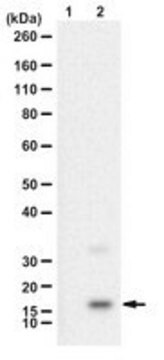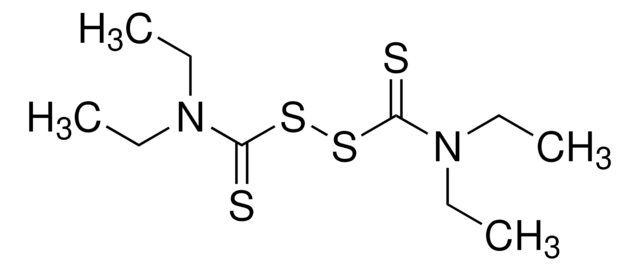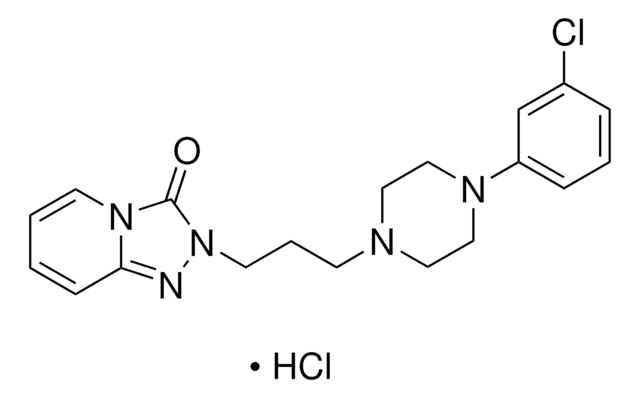ABE2578
Anti-H3Q5histaminyl
Sinonimo/i:
Histone H3Q5;H3Q5;Histone H3 glutamine5 Histaminyl
About This Item
Prodotti consigliati
Origine biologica
rabbit
Livello qualitativo
Coniugato
unconjugated
Forma dell’anticorpo
purified antibody
Tipo di anticorpo
primary antibodies
Clone
polyclonal
PM
calculated mol wt 15.51 kDa
observed mol wt ~16 kDa
Reattività contro le specie
human
Reattività contro le specie (prevista in base all’omologia)
bovine, monkey
Confezionamento
antibody small pack of 100 μL
tecniche
dot blot: suitable
western blot: suitable
Isotipo
IgG
Sequenza dell’epitopo
N-terminal
N° accesso ID proteina
N° accesso UniProt
Condizioni di spedizione
ambient
modifica post-traduzionali bersaglio
histaminylation (Gln6)
Informazioni sul gene
human ... HIST3H3(8290)
Descrizione generale
Specificità
Immunogeno
Applicazioni
Evaluated by DOT Blot analysis with H3Q5Histaminyl peptide
Dot Blot Analysis: A 1:1,000 dilution of this antibody detected H3Q5Histaminyl peptide, but not the unmodified H3Q5 peptide.
Tested Applications
Western Blotting Analysis: A representative lot detected H3Q5histaminyl in lysate from Transglutaminase 2 (TGM2) overexpressing HEK293T cells treated with Histamine, but not in untreated cells or in cells treated with Serotonin or Dopamine. (Data courtesy of Dr. Ian Maze′s Lab, Icahn School of Medicine at Mount Sinai, New York).
Western Blotting Analysis: A 1:1,000 dilution of this antibody detected Histone H3Q5histaminyl in lysates from HEK293T cells over expressing TGM2 and treated with histamine, but not in untreated cells.
Dot Blot Analysis: A 1:1,000 dilution of a representative lot of this antibody detected H3Q5histaminyl peptide, but not serotonin or dopamine modified peptides. (Data courtesy of Dr. Ian Maze s Lab, Icahn School of Medicine at Mount Sinai, New York).
Activity Assay (In vitro): A representative lot of this antibody detected the recombinant Histone H3.3 histaminylated on glutamine 5 following in vitro transamidation reaction in the presence of histamine. (Data courtesy of Dr. Ian Maze Lab, Icahn School of Medicine at Mount Sinai, New York).
Note: Actual optimal working dilutions must be determined by end user as specimens, and experimental conditions may vary with the end user
Stato fisico
Stoccaggio e stabilità
Altre note
Esclusione di responsabilità
Non trovi il prodotto giusto?
Prova il nostro Motore di ricerca dei prodotti.
Codice della classe di stoccaggio
12 - Non Combustible Liquids
Classe di pericolosità dell'acqua (WGK)
WGK 1
Punto d’infiammabilità (°F)
Not applicable
Punto d’infiammabilità (°C)
Not applicable
Certificati d'analisi (COA)
Cerca il Certificati d'analisi (COA) digitando il numero di lotto/batch corrispondente. I numeri di lotto o di batch sono stampati sull'etichetta dei prodotti dopo la parola ‘Lotto’ o ‘Batch’.
Possiedi già questo prodotto?
I documenti relativi ai prodotti acquistati recentemente sono disponibili nell’Archivio dei documenti.
Il team dei nostri ricercatori vanta grande esperienza in tutte le aree della ricerca quali Life Science, scienza dei materiali, sintesi chimica, cromatografia, discipline analitiche, ecc..
Contatta l'Assistenza Tecnica.








